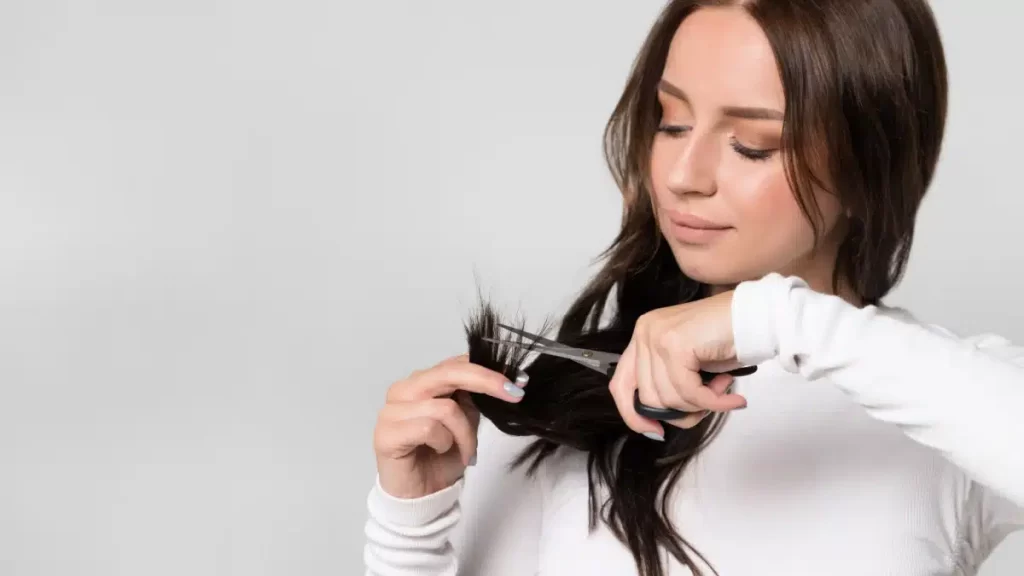How To Cut Your Own Hair at Home
According to Google Trends, searches related to cutting your own hair peaked during the lockdown in 2020. However, knowing how to trim your hair is still in demand.
Cutting your hair at home can be an empowering and time-saving endeavor in do-it-yourself grooming.
Is It Possible To Cut Your Own Hair?
Is it a good idea to cut your own hair? Some hairdressers would say no, especially regarding more intricate styles like pixie haircuts.

However, if you are determined and want to do it, it is definitely possible. You can have a new haircut without leaving the house with the proper tools, techniques, and tips hairstylists are happy to share.
Plus, you will save some money!
The Process of Cutting Your Hair Yourself
Whether you’re looking to trim split ends, maintain your current style, or experiment with a fresh look, understanding the process of self-haircutting is essential. In this section, we’ll guide you through a step-by-step approach, providing valuable tips and techniques to help you achieve professional-looking results from the comfort of your home.
Step 1: Assemble What You Need
First, prepare the tools you will need for this DIY haircutting. The key is to use the right tools. Here are some you might require:
- Shears – Don’t use regular kitchen scissors to cut your hair. Instead, use shears. Their blade is made especially for hair cutting, designed with a grip that helps you move your wrist comfortably.
- Alligator Section Clips – These clips can hold a lot of hair at once. Plus, they are not leaving creases on the hair.
- Cutting Cape – To protect your clothes, you can wear a cape. Everything you cut will go straight to the floor.
- Cutting Comb – A good comb can help when you cut your hair at home. It should have two sides, a wide tooth and a fine tooth. You will need both of these sides to help with your hair sections.
- Disinfectant – Don’t forget to clean your tools before and after use.
Step 2: Prepare
While the general rule of thumb is not to cut your hair wet, you can try if you have experience cutting hair. Cutting damp or dry hair can also depend on your hair texture.
Unless you have curly hair, don’t wet it thoroughly before cutting.
Before cutting your hair, consider shampooing and conditioning it. Dirty and oily hair tends to stick together, resulting in an uneven finish. Therefore, achieving a smooth, dry, clean hair texture is essential before cutt
Step 3: Split Your Hair
It’s crucial to section your hair properly. Start by splitting your hair into at least four sections.
Divide your hair in half from ear to ear and tie or pin the top half up. Then section the top half and bottom half into more sections. Use a clipper or scrunchie. This kind of sectioning will help you cut your hair equally.
It is essential to keep your natural hairline in place. Use a wide comb to prepare each section for cutting.
Step 4: Trim One Section at a Time
If you have decided to cut your own hair, it is crucial to trim one section at a time rather than going bolder.
Untie it section by section, comb or brush through it, and ensure it is fully detangled. Use your fingers as a guide on how much you should cut.
Use a fine tooth side of your comb to bring all the hair together. Decide where you can cut by using your first and middle fingers and keeping a tight grip. Hold the shears up against the fingers and then cut a straight line.
Suppose you are satisfied with the length – great! However, if you are not, cut more of your hair. Leave this cut section down, so you can use it as a guide for the next sections.
Step 5: Cut The Front
Since you have cut the first section, now is the time to cut the rest and the front. Use your fingers and the fine side of the comb to match the length of the opposite side. Gather both sides of the hair together and see if they are even.
If you are not a fan of blunt cuts or your hair is thick, bring ends up, point cut into them, and cut them by making y-shapes with scissors.
Step 6: Cut The Back
Now you have finished the front, it is time for those back sections. Be cautious, though. These rear sections will be longer. Hair falls at a different angle, so you must keep the line straight. Whatever you do, don’t make the back sections longer than the front.
A good tip from hairstylists is to look over your shoulders and see if the lines are straight. You can turn and see if everything is in line.
Step 7: Additional Layers and Framing
If you are up for something bolder, consider face framing and adding some layers to your hairstyle. It is an optional step, but it will elevate your haircut if you do it right.
Hairdressers recommend a technique called slide cut. You use your fingers again, starting around the cheekbones, and pull a small part of your hair in front. Then slowly slide down with the open shears. It will give you a soft finish.
When it comes to layers, you can achieve them at home as well. All you need to do is take vertical sections, bring them forward at around a 90-degree angle, and cut. The higher you raise the hair, the higher layers will be.
Step 8: Cleaning and Styling
You must clean your tools afterward, no matter how long it takes you to do your hair. Use water and disinfectant, and leave the tools somewhere where you can quickly grab them for the next cut.
Quality hair styling products are always a good idea, especially if you do your haircut yourself.
You can use something that will seal the cuticle after cutting. Also, a texturizing spray will make your hair look messy yet chic, giving it some body and shape.
Dos and Don’ts of Cutting Your Hair by Yourself
When it comes to cutting your hair, there are a lot of things that can go wrong. Keep these things in mind to save yourself from trouble.
- Do cut your hair in the bathroom. Avoid all kinds of carpets. Standing in a well-lit area in front of a mirror is the most convenient.
- Don’t cut your wet hair. Hair bounces when it dries, so you can easily cut more than you originally planned.
- Do trim less than you think you should. The key to not over-cut your hair is to do it slowly. You can easily cut more later, but if you trim too much – it’s too late.
- Don’t cut your hair ends straight. Since you are not a professional, it will be tough to make them really straight. They can turn out chunky and bulky. Layers are a better option.
What if I Mess Up?
So, is that fringe uneven? The sides could be straight. It’s not the end of the world. It happens, especially if you cut your hair yourself for the first time. Here are some ways to cover the mistakes.
- If you have cut your bangs too short, you can dry and style them and then see if you need to use your scissors again. If that is not working, you can always use a headband or a clip and wait for your hair to grow.
- Blowing your hair and using certain hairstyle products can blend the mistakes. The key is to style your hair wet and to use an air-dry creme.
- Updos and braids are great for hiding badly cut hair. Also, don’t hesitate to use accessories like headbands, clips, and barrettes.
Final Words
Cutting your hair at home can be a rewarding and cost-effective way to maintain your style or try something new. Remember to take your time, trim slowly, and be cautious with each cut to avoid major mishaps. And if you do make a mistake, don’t fret! There are various ways to cover up or style your hair to minimize the impact of any errors.




